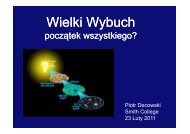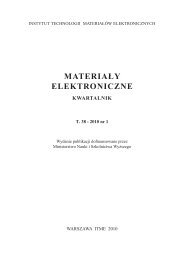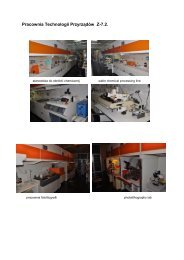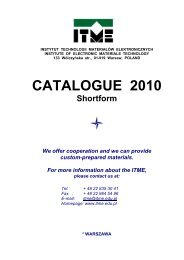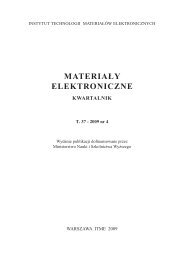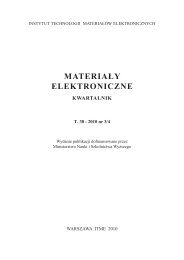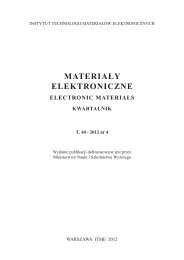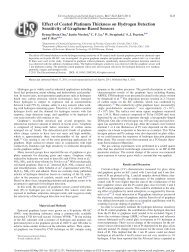Nr 1 - ITME
Nr 1 - ITME
Nr 1 - ITME
You also want an ePaper? Increase the reach of your titles
YUMPU automatically turns print PDFs into web optimized ePapers that Google loves.
Influence of stencil design and parameters of printing process...<br />
devices can be achieved in case of stencil apertures designed with rounded corners.<br />
It thus arise from that the radius of the rounding of the aperture corner is higher<br />
than the radius of solder paste grains.<br />
Oblong apertures are the particular case of apertures with rounded corners. This<br />
shape of aperture is recommended in screen printing process for multi-leads integrated<br />
circuits.<br />
7. CONCLUSIONS<br />
For lead-free assembly of fine pitch devices the formation of acceptable and<br />
repeatable solder paste deposits first of all depends on two group of factors. First<br />
group includes stencil material, stencil forming technique and stencil thickness.<br />
Fundamental factors of second group are size and shape of stencil apertures.<br />
In our investigation the appreciation of correctness of solder paste printing based<br />
on experimental trials of different kinds of stencils and on analyses of solder paste<br />
transfer efficiency.<br />
For the stencils with apertures having the same shape and size as the pads on<br />
the boards it was noticed that stencil made with nickel by electroforming technique<br />
gave the best results. Laser cut stainless steel stencil had comparable utilizable<br />
properties. Obtained an average transfer efficiency was as follows: 95% on pads<br />
for CSP, 79% on pads for 0201 and 84% on pads for BGA components for nickel<br />
stencil and 89% on pads for CSP, 82% on pads for 0201 and 80% on pads for BGA<br />
components for steel stencil.<br />
The better transfer efficiency was stated for stainless steel stencil when apertures<br />
have rounded corners: nearly and over 100% on pads for 0201 and CSP and about<br />
95% on pads for BGA components. The design of stencil aperture with rounded<br />
corners improves printing paste and should be used for small pads.<br />
The result of trials indicates that the stencils made with nickel electroformed<br />
technology and apertures with rounded corners are needed for achieving optimal<br />
transfer of solder paste in fine pitch devices assembly.<br />
REFERENCES<br />
[1] Belmonte J., Boyes B., Johnson A.: SMT step by step. Step 4: Printing, SMT, April,<br />
(2005), 50-53<br />
[2] Chrys Shea: Optimizing stencil design for lead-free SMT processing, Proceedings of the<br />
SMTA International Conference, Chicago, 2004<br />
84




